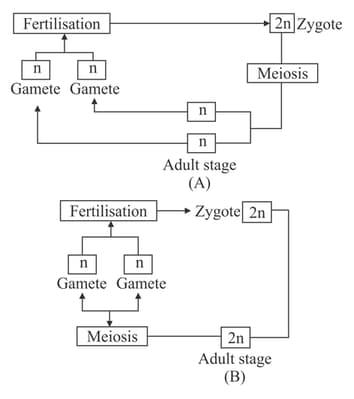Life Cycles in Plants
Life Cycles in Plants: Overview
This topic covers concepts, such as, Haplontic Life Cycle, Diplontic Life Cycle & Haplo-diplontic Life Cycle etc.
Important Questions on Life Cycles in Plants
The most distinct alternation of generation is found in:-
Which one of the following has haplontic life cycle?
Comparable to angiosperms, which of the following algae exhibits diplontic life cycle?
In these figures, two life cycles are described. Mark the correct option.

How many of the given statements (I-IV) about different plant groups are not correct?
I- Majority of pteridophytes are heterosporous.
II - Pollination in gymnosperms is direct and anemophilous.
III - The first stage of moss gametophyte is leafy stage, which develops directly from spore.
IV - In flowering plants, endosperm is triploid and is pre-fertilisation structure.
Choose the odd one w.r.t. life cycle pattern.
Consider the following statements about the sporophytic generation:
A. Generation that produces the spores
B. The generation that possesses vascular tissue
C. The diploid generation
Correct statements are
**Formatting of the question and option was changed.**
The most common type of life cycle in algae is
Which pattern of life cycle is exhibited in bryophyte and pteridophyte?
The life cycle pattern of spermatophytes is:
Zygote of an organism developed after syngamy undergoes meiosis to form haploid spores, which divide mitotically and form the gametophyte. The organism must have ___________________________________life cycle.
Spirogyra is a sexually reproducing alga in which vegetative thallus is haploid. In Spirogyra, meiosis:
Assertion: Spirogyra shows haplontic life cycle.
Reason: Zygotic meiosis occurs in Spirogyra.
Distinct alternation of generation is found in
Which of these have diplontic life cycle?
